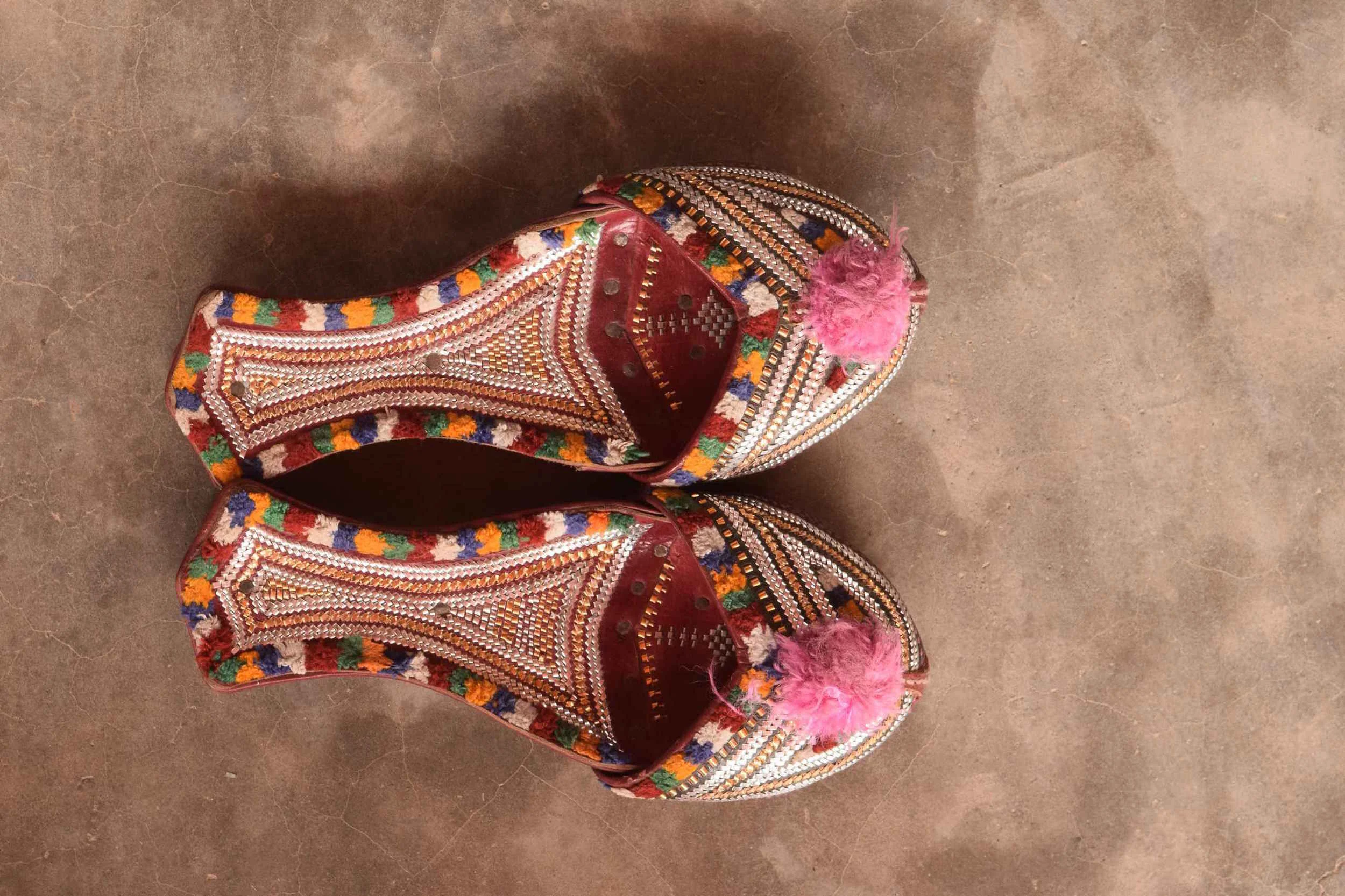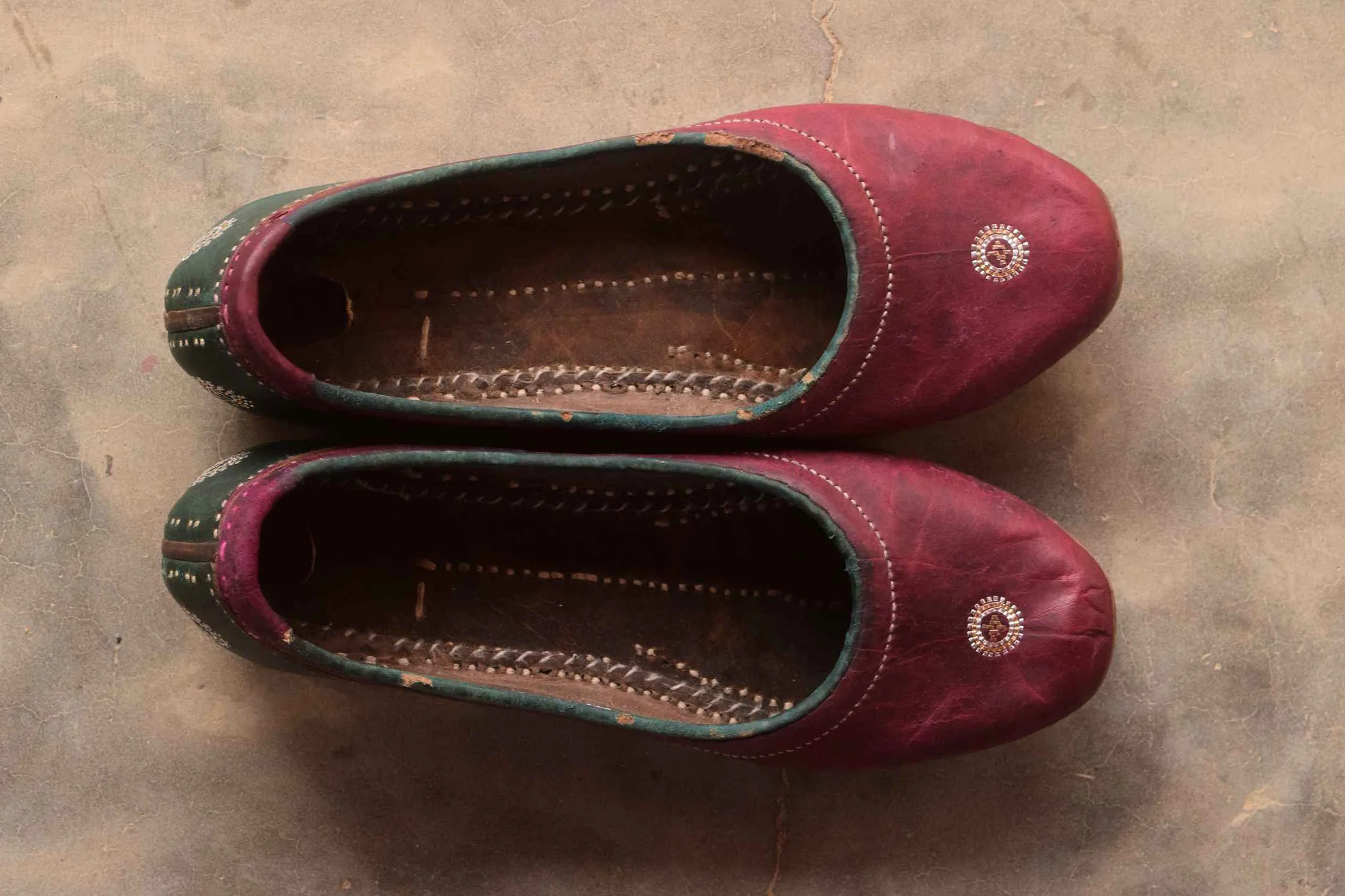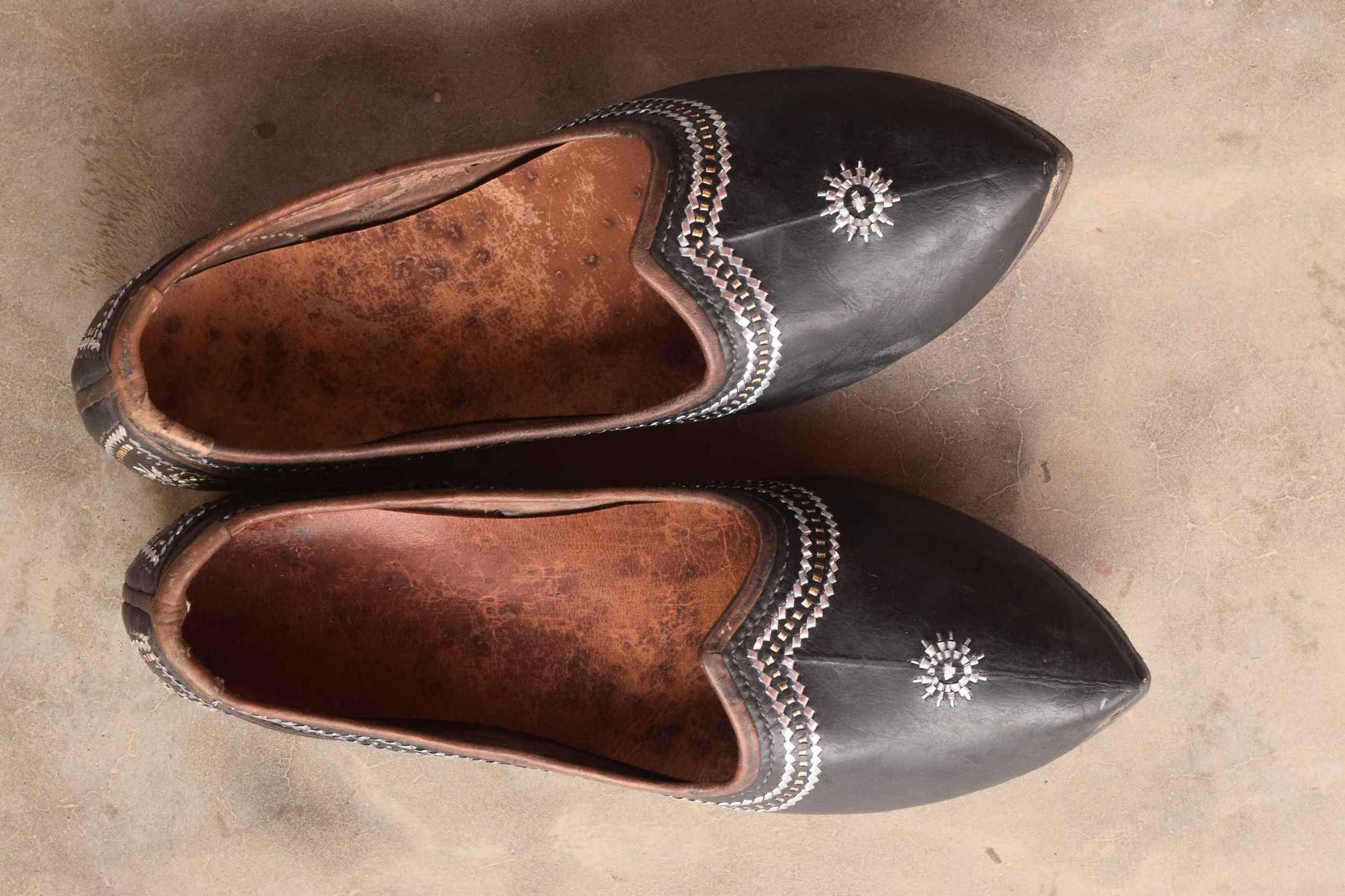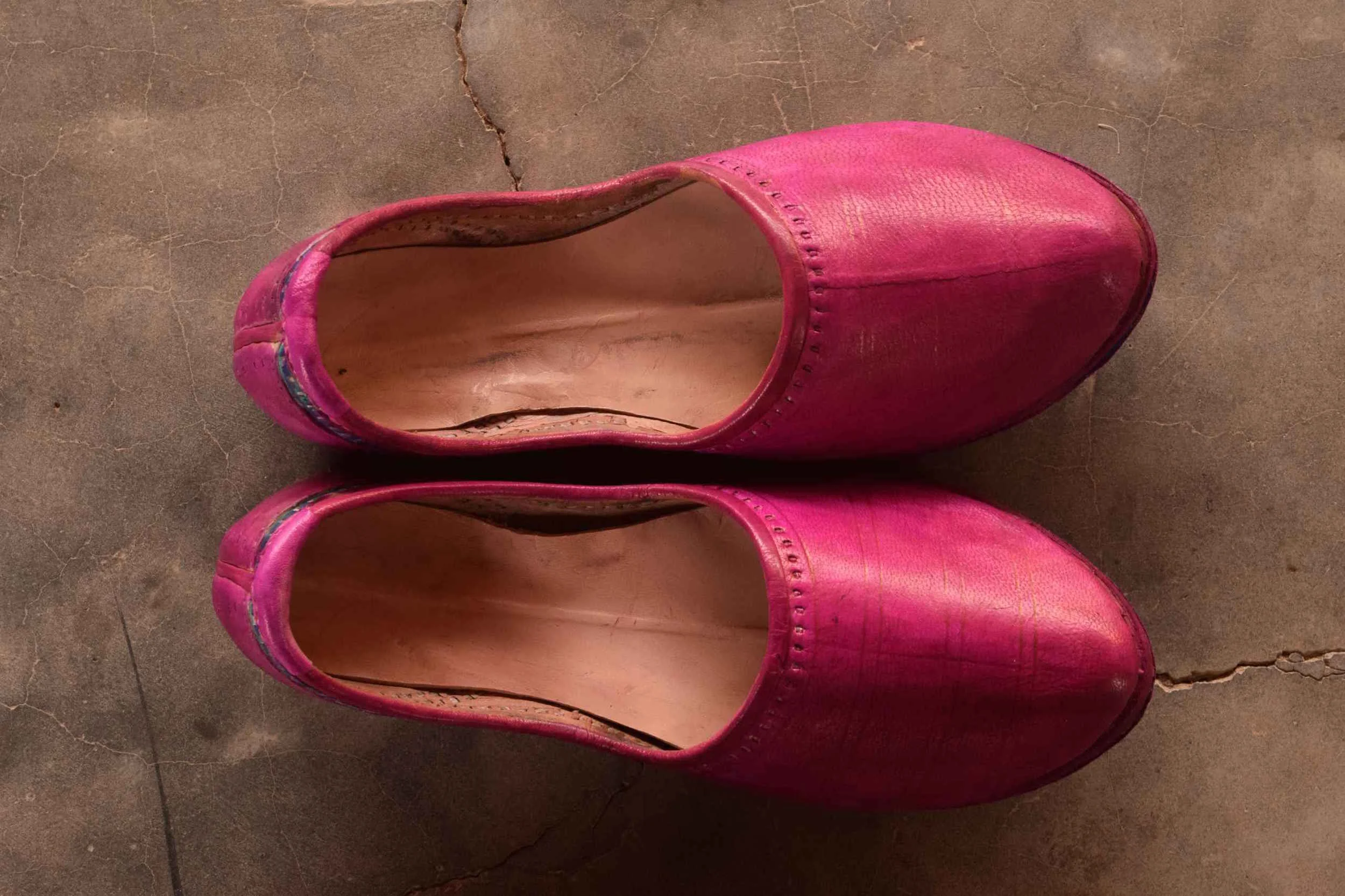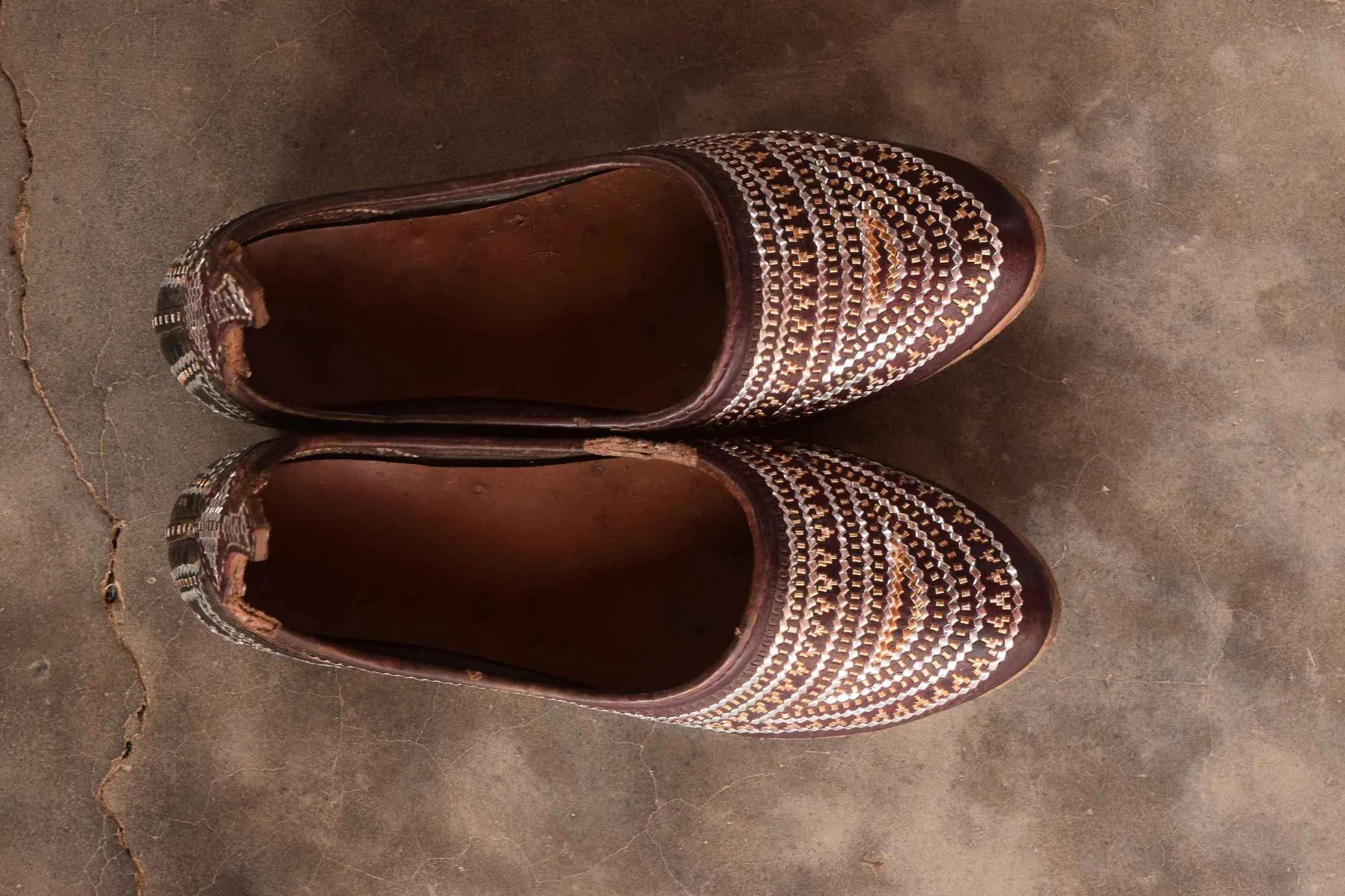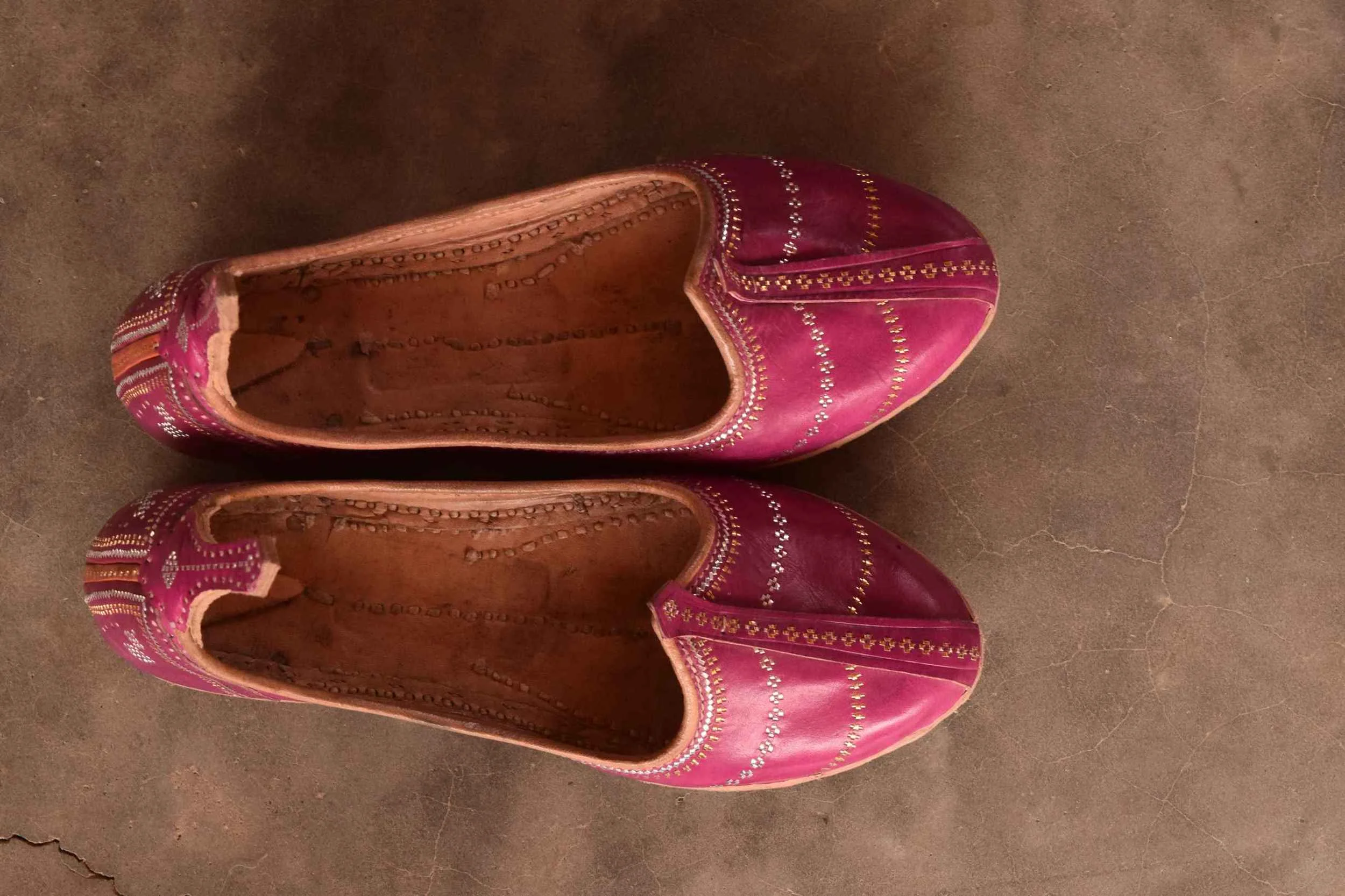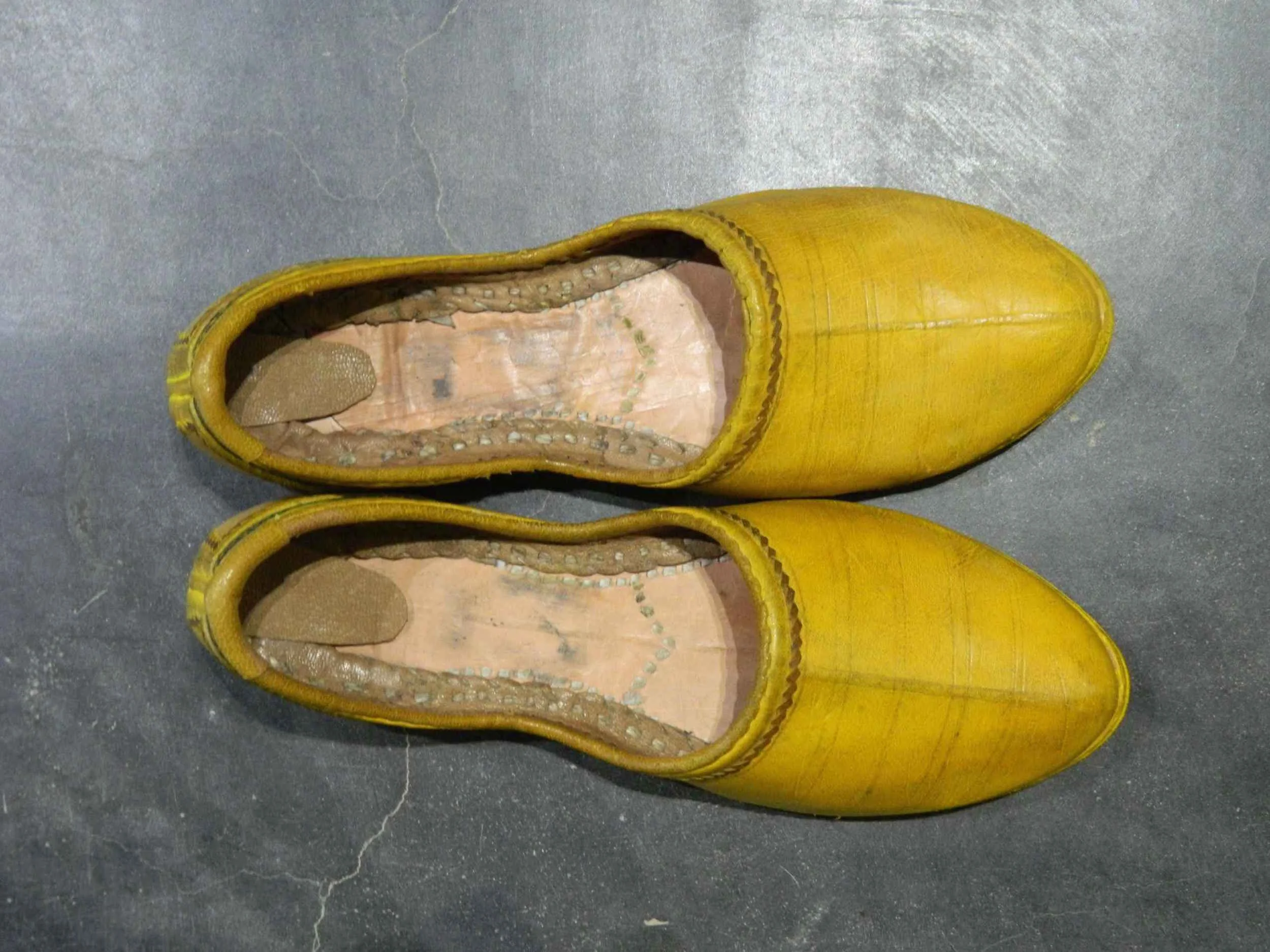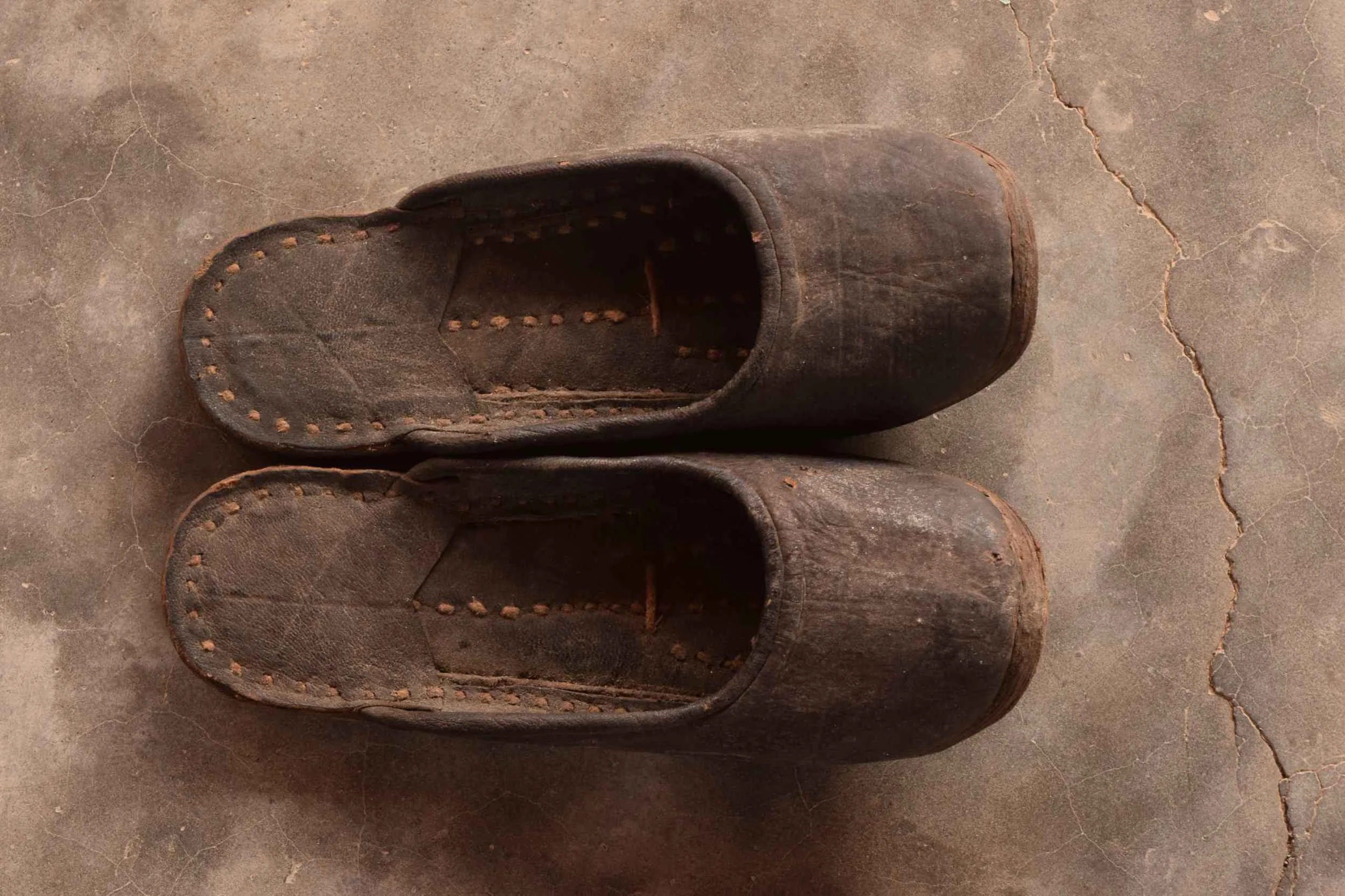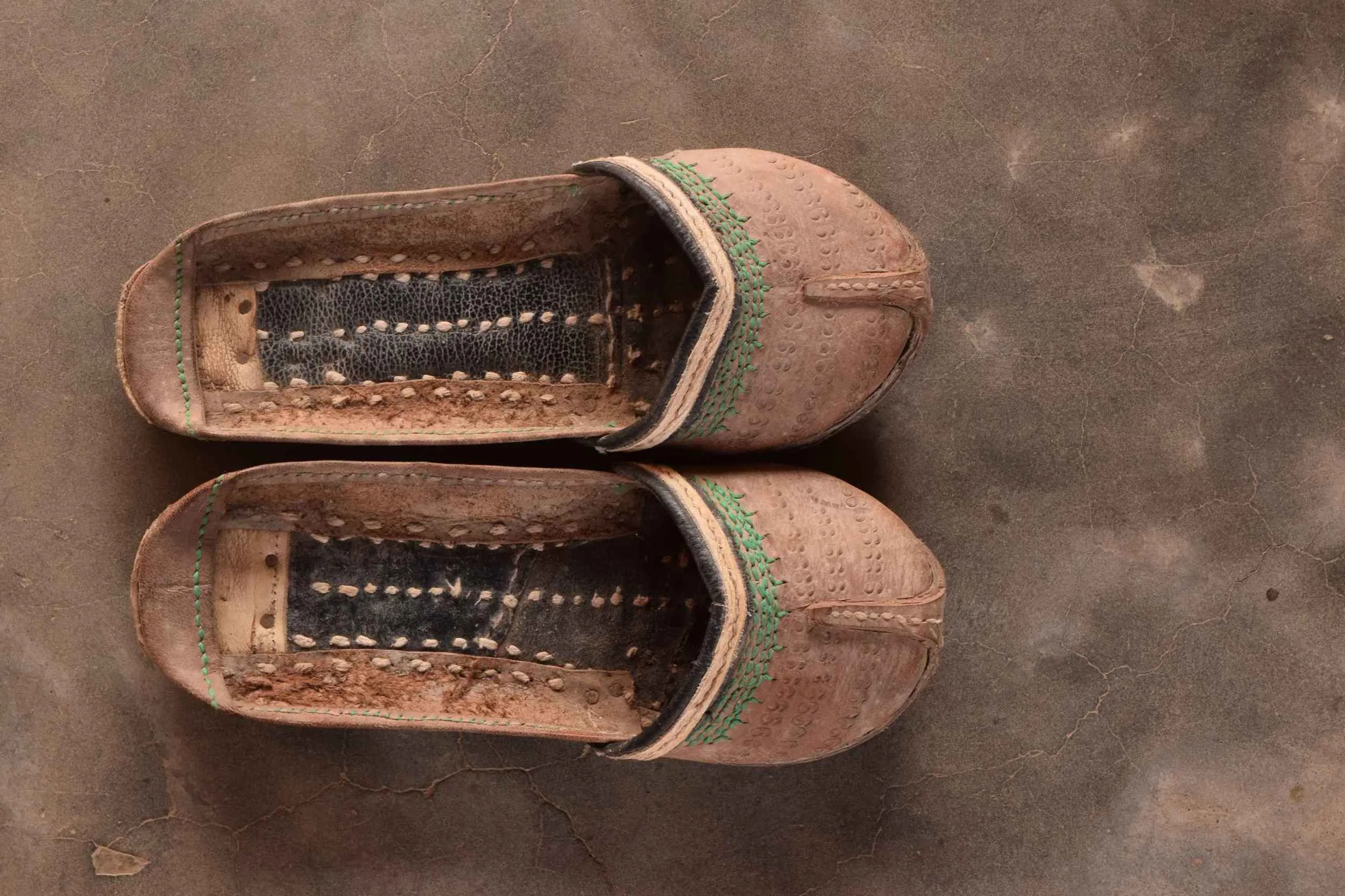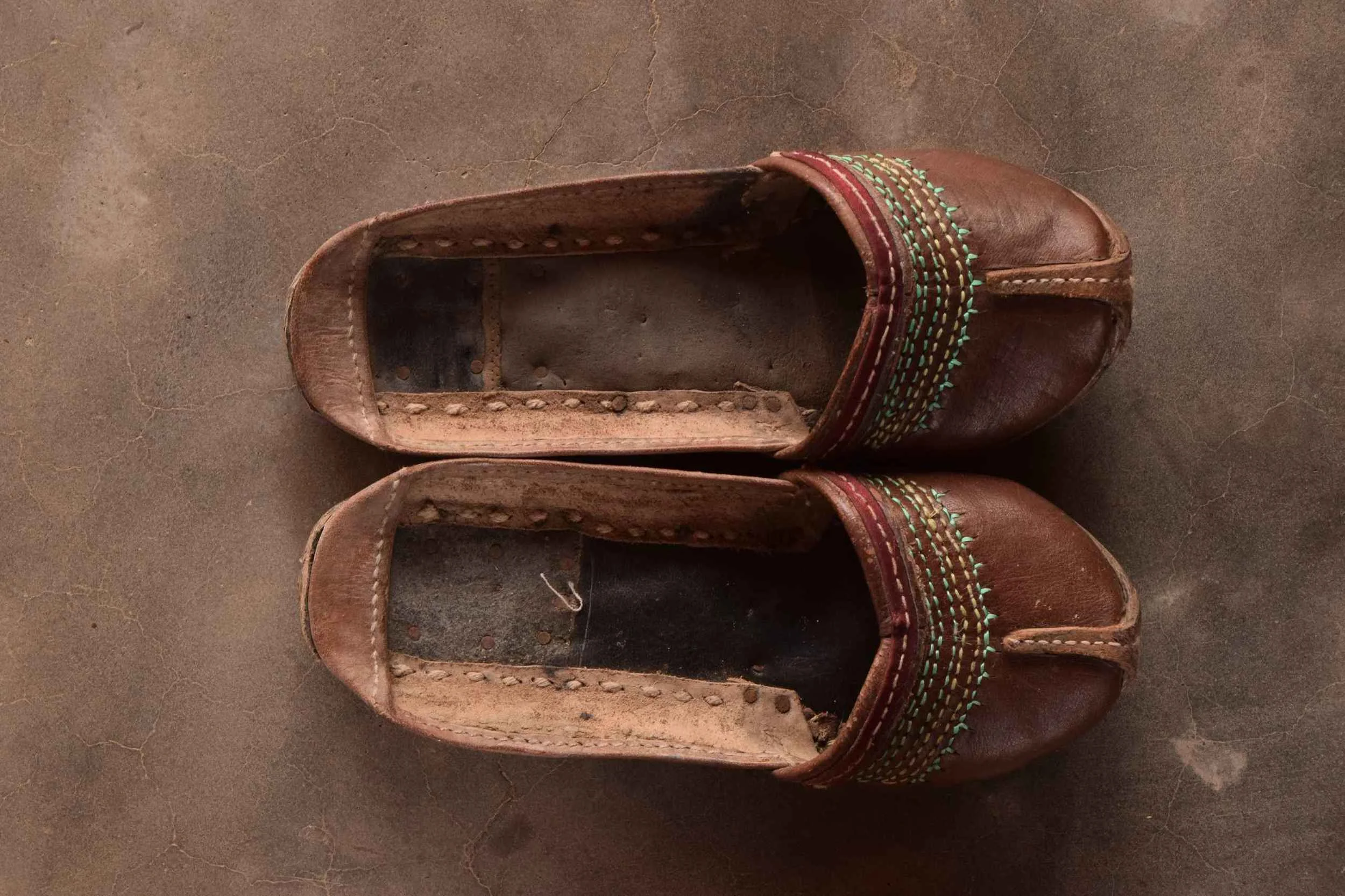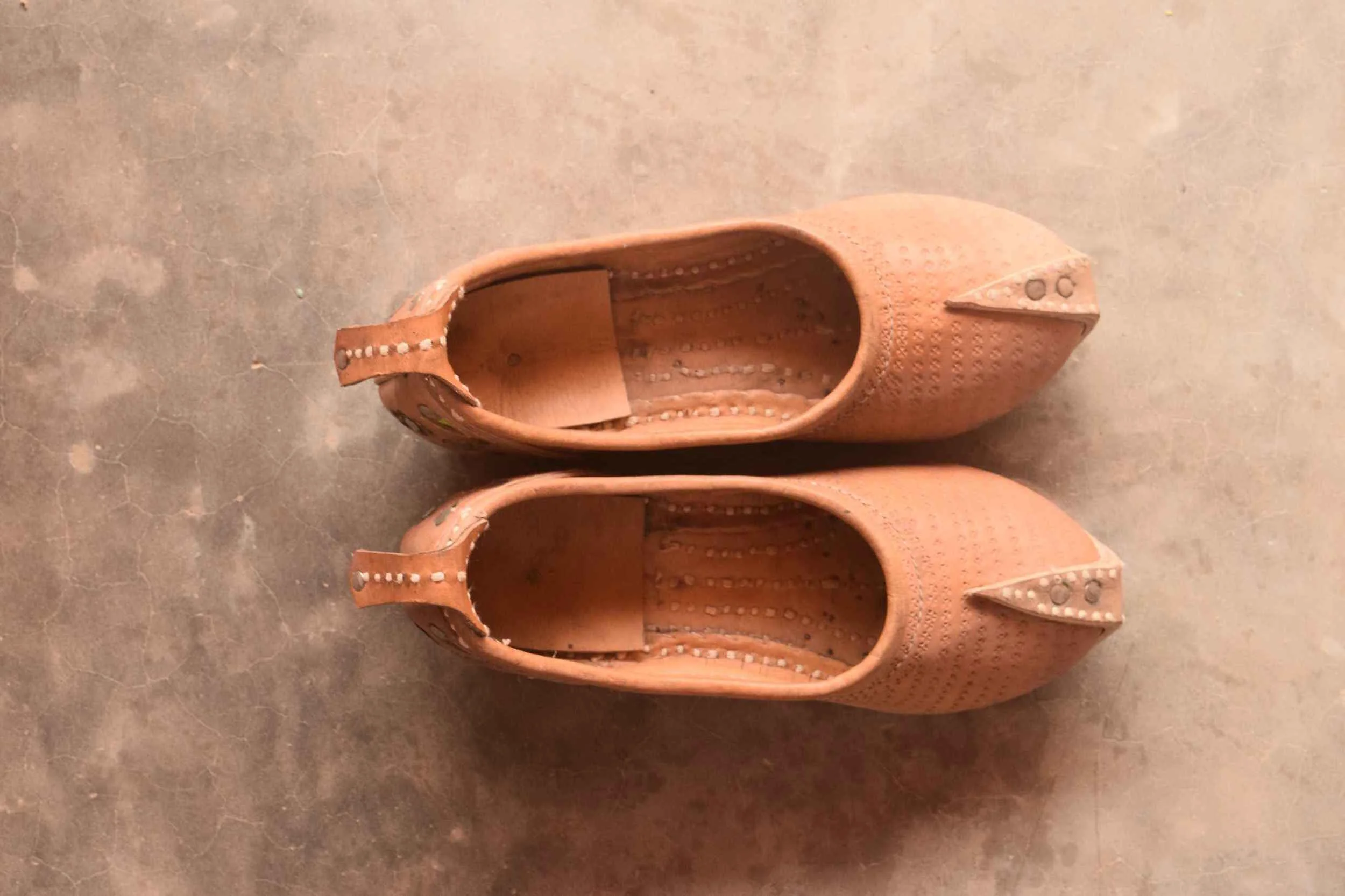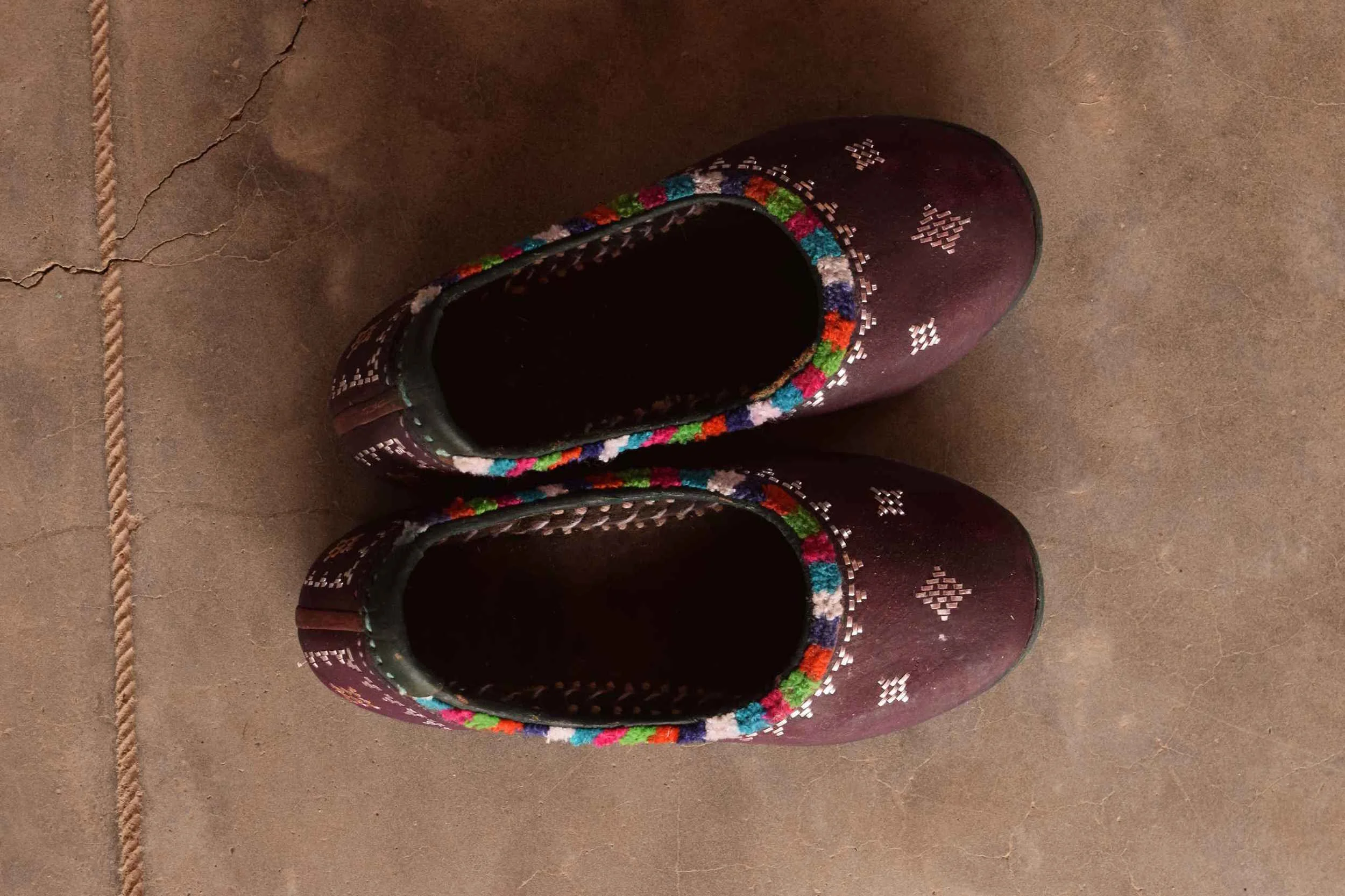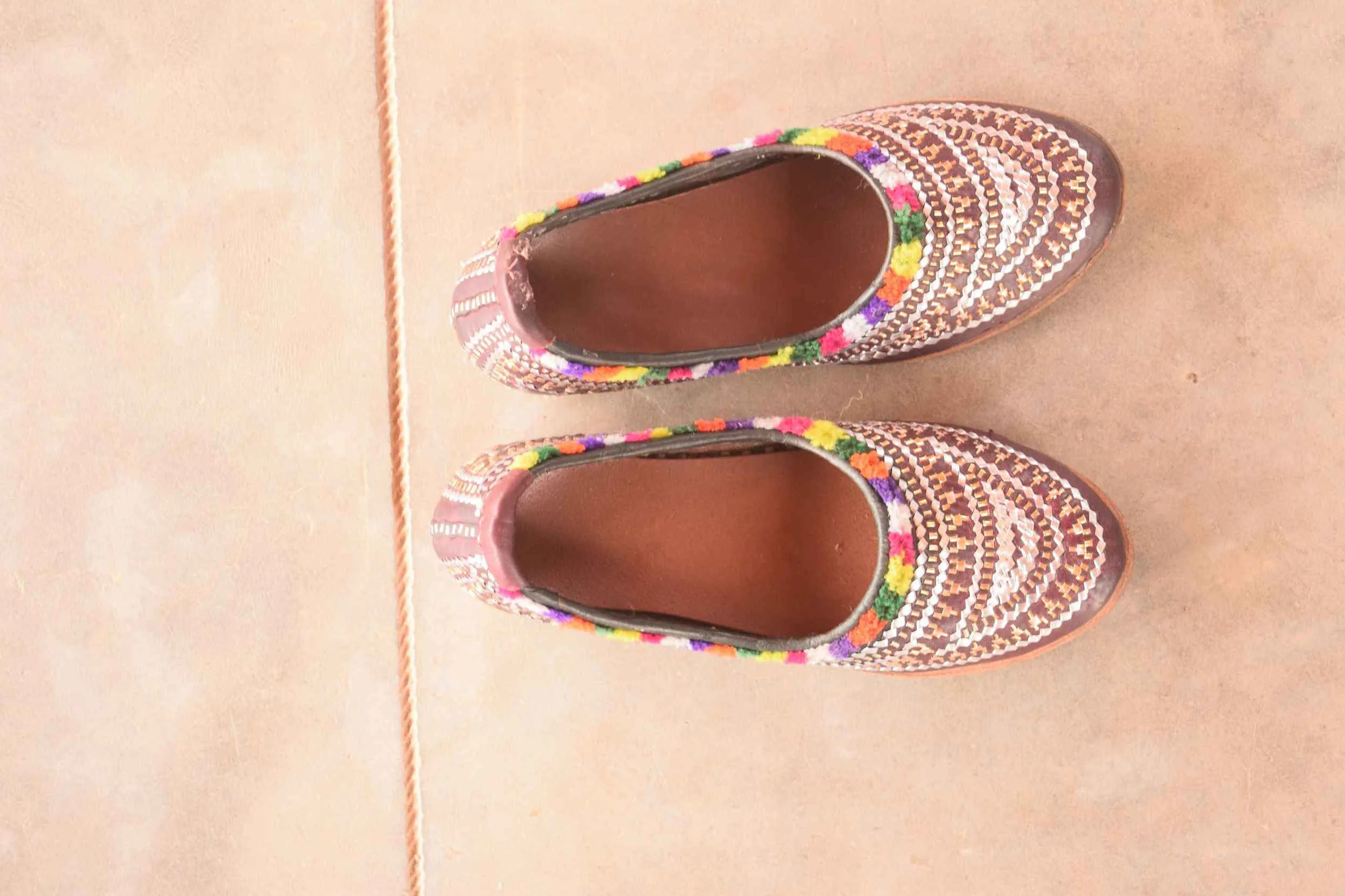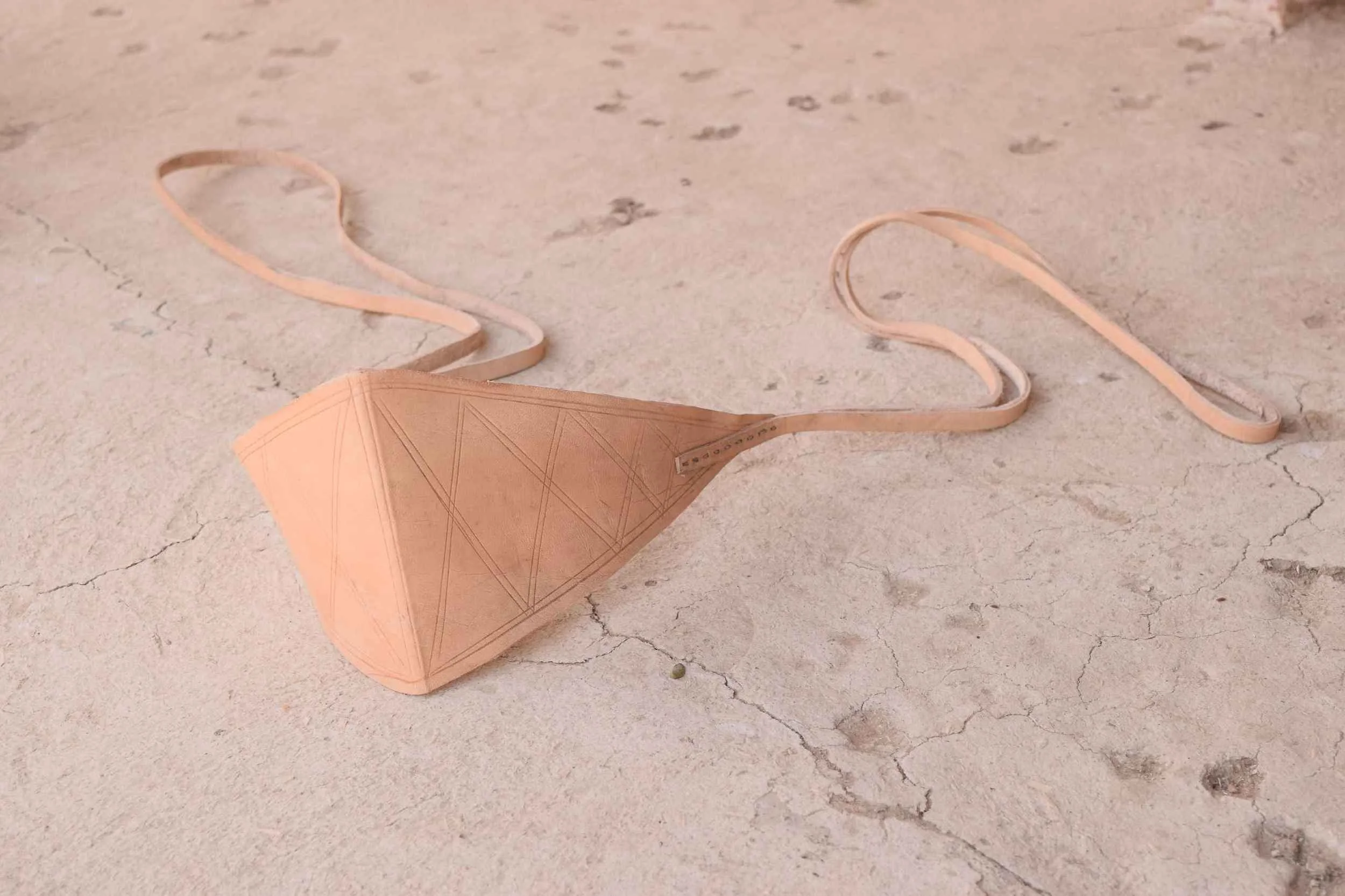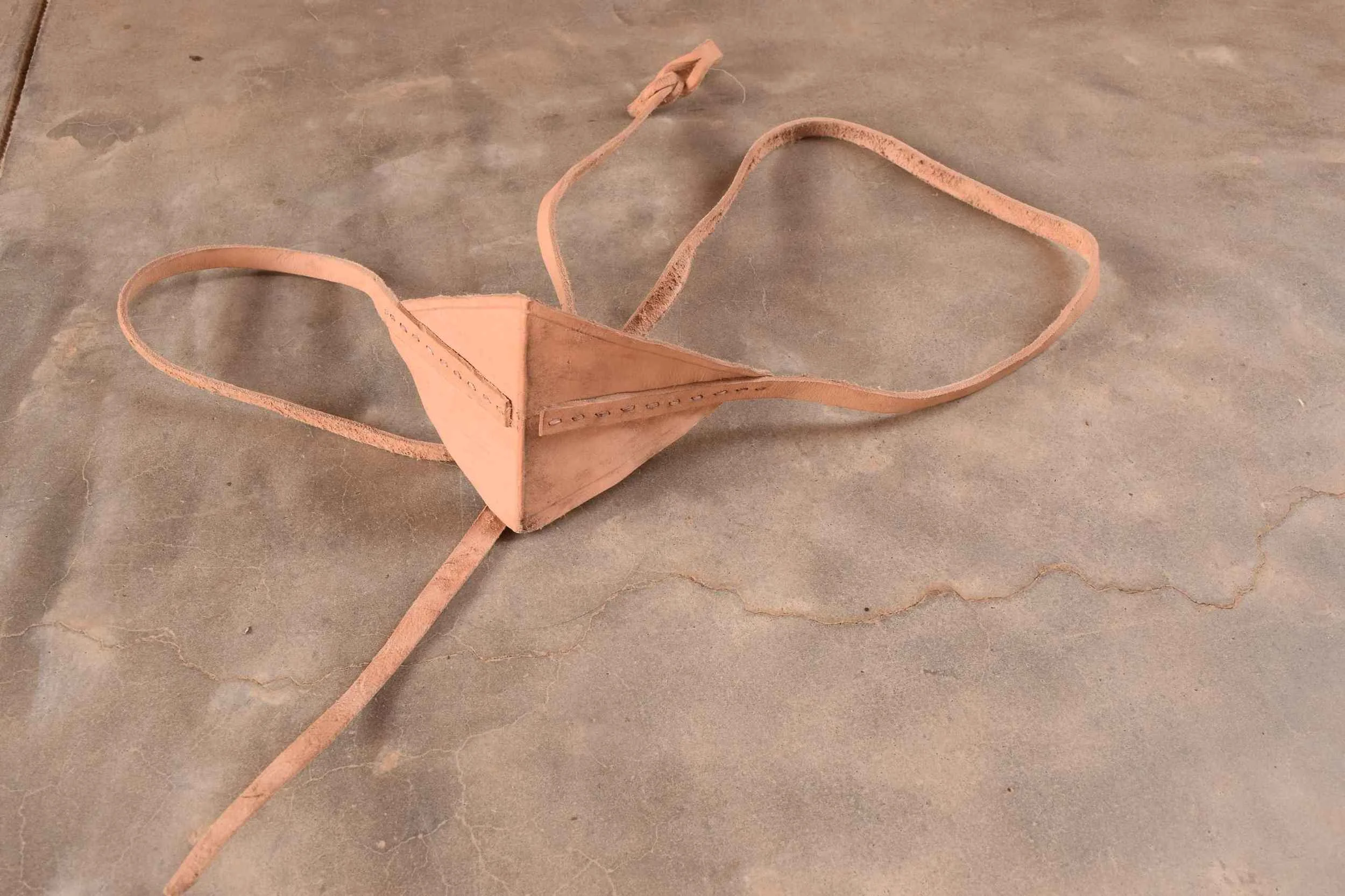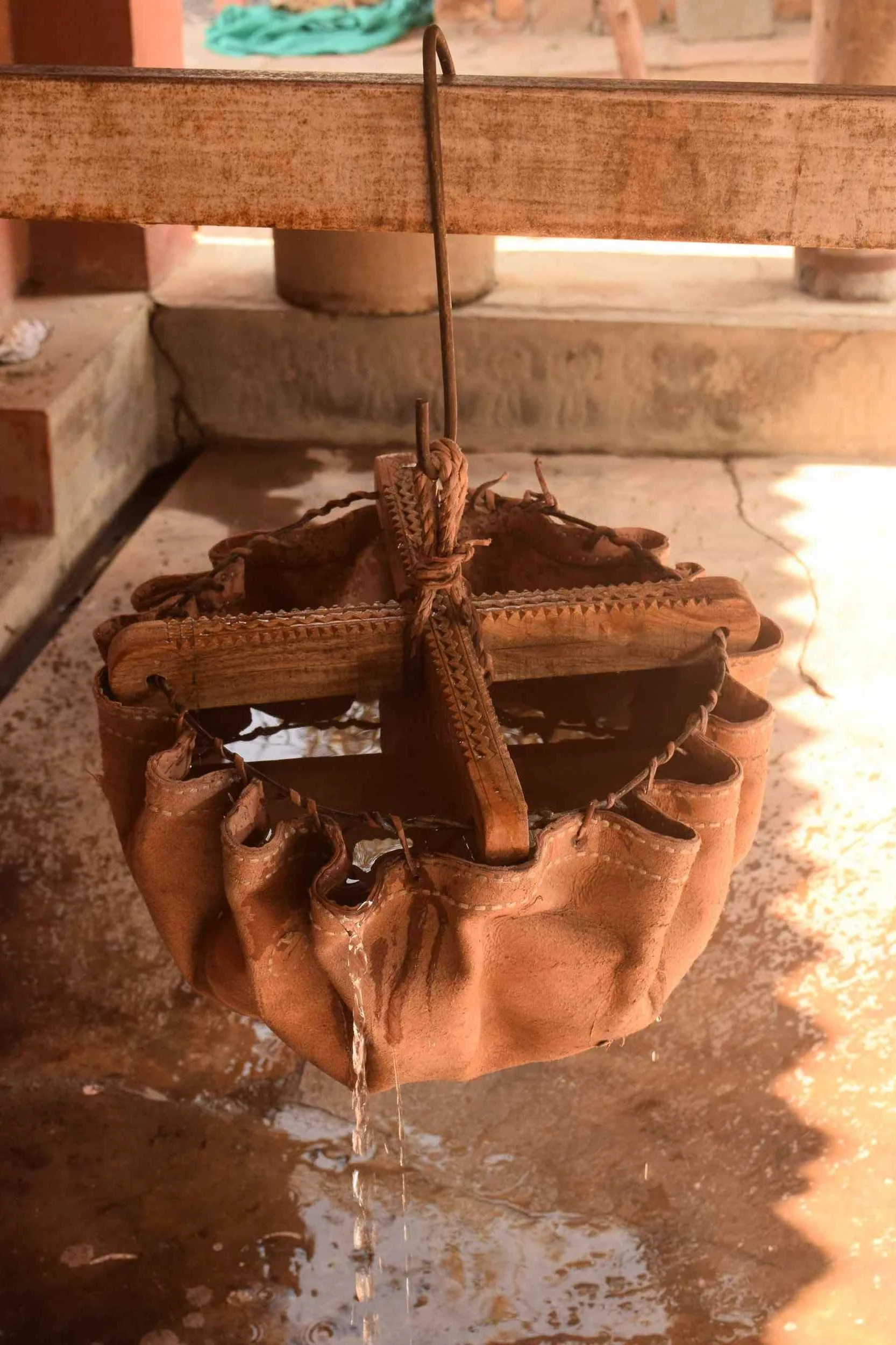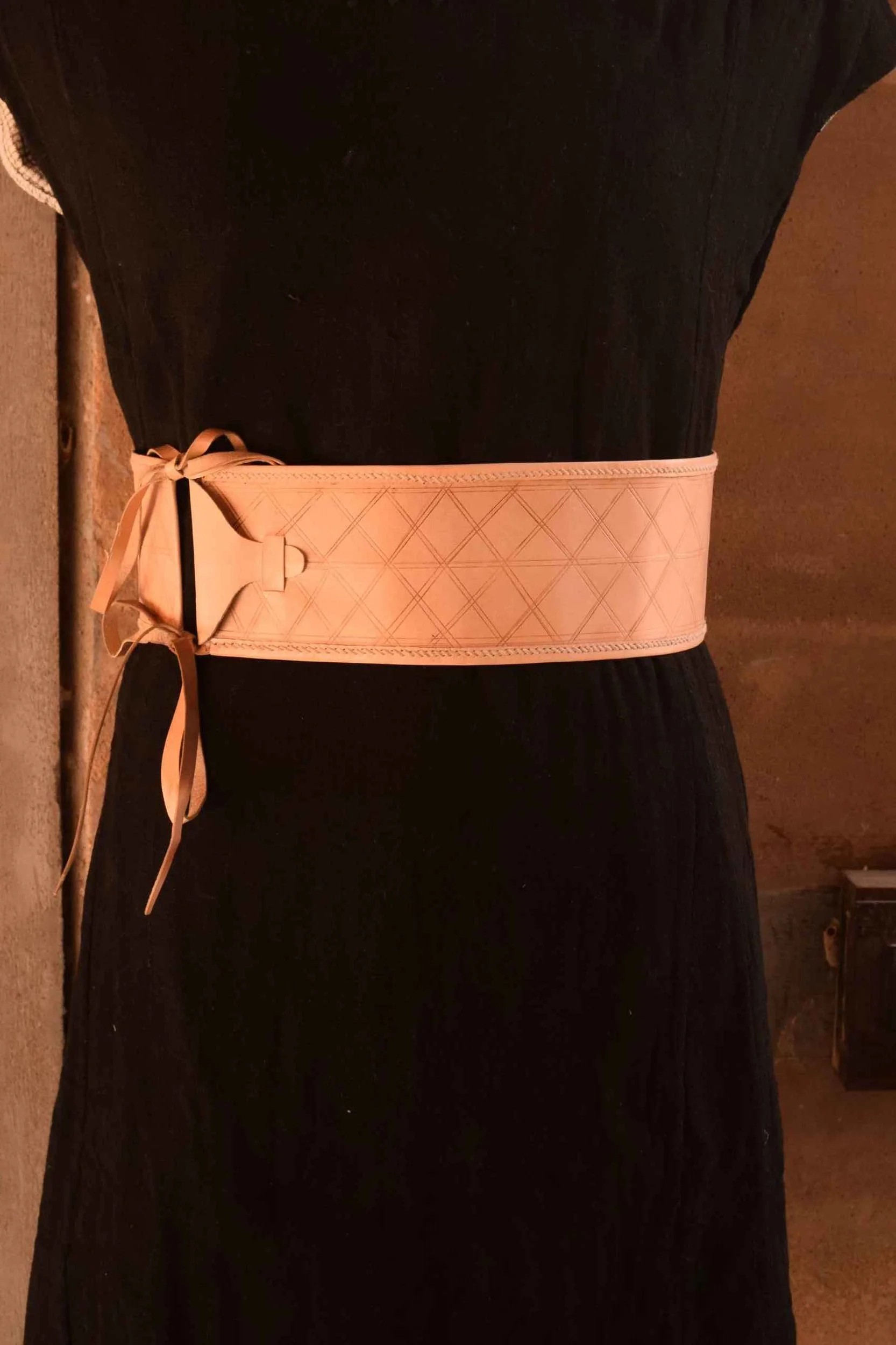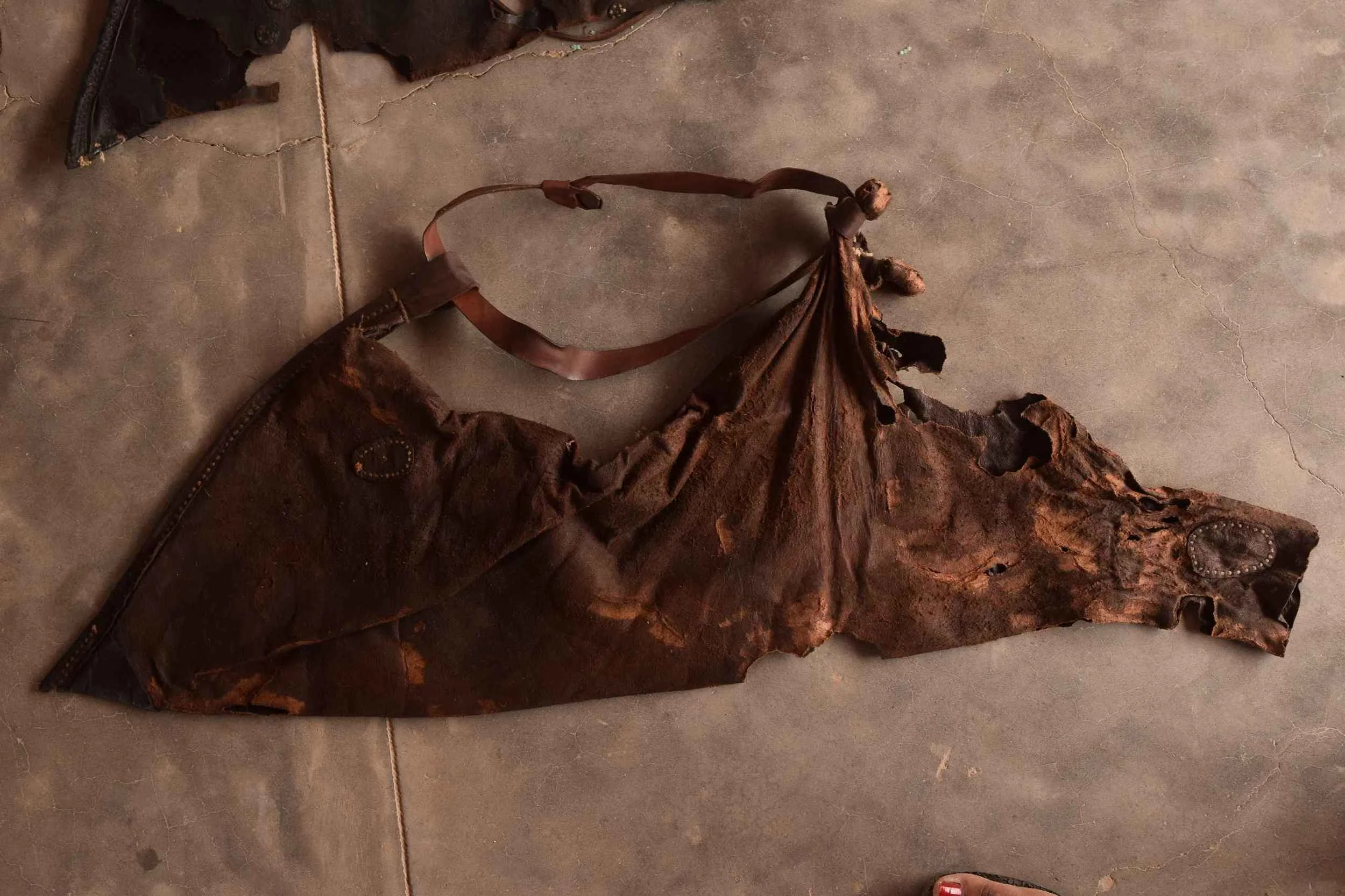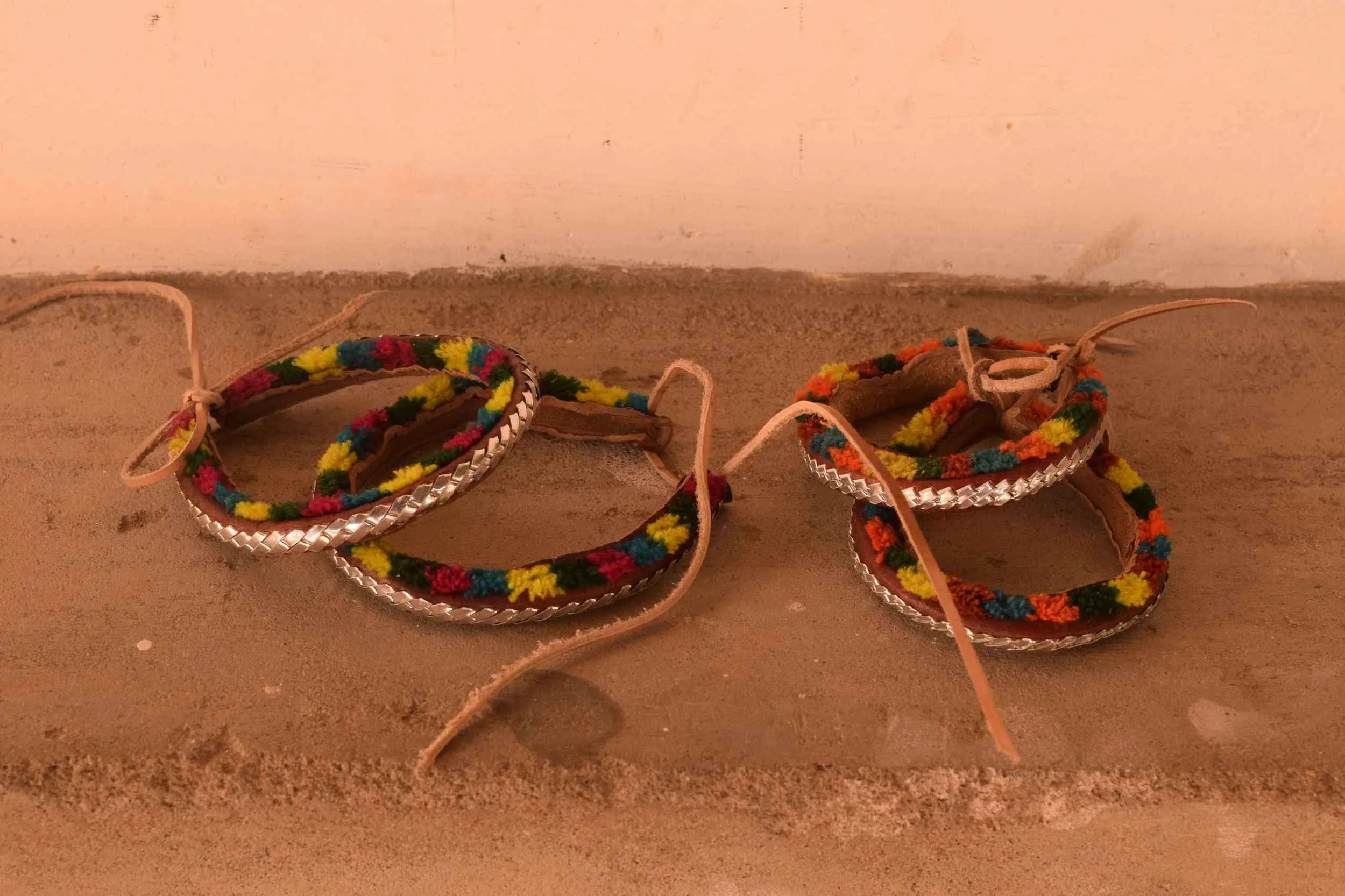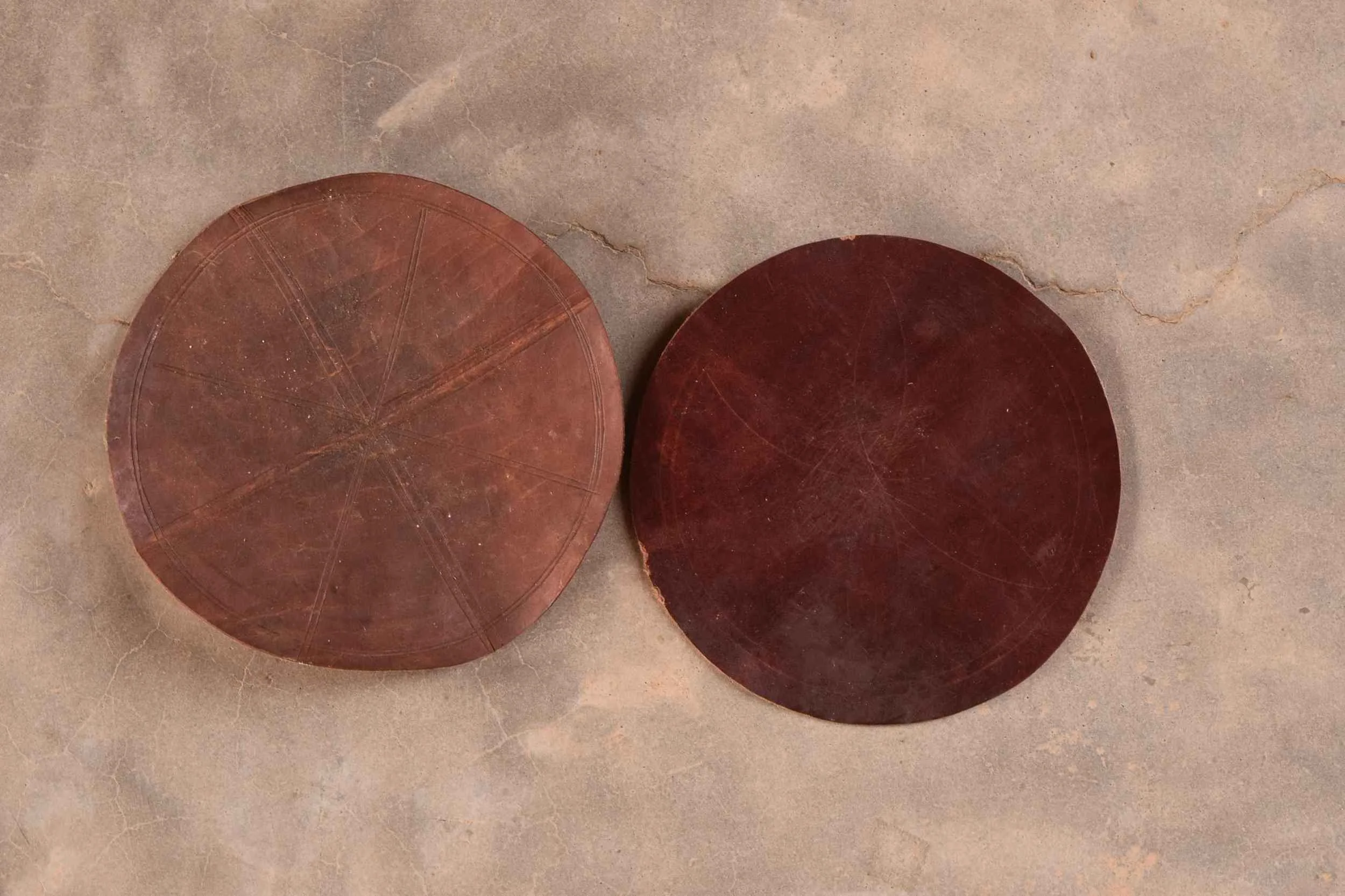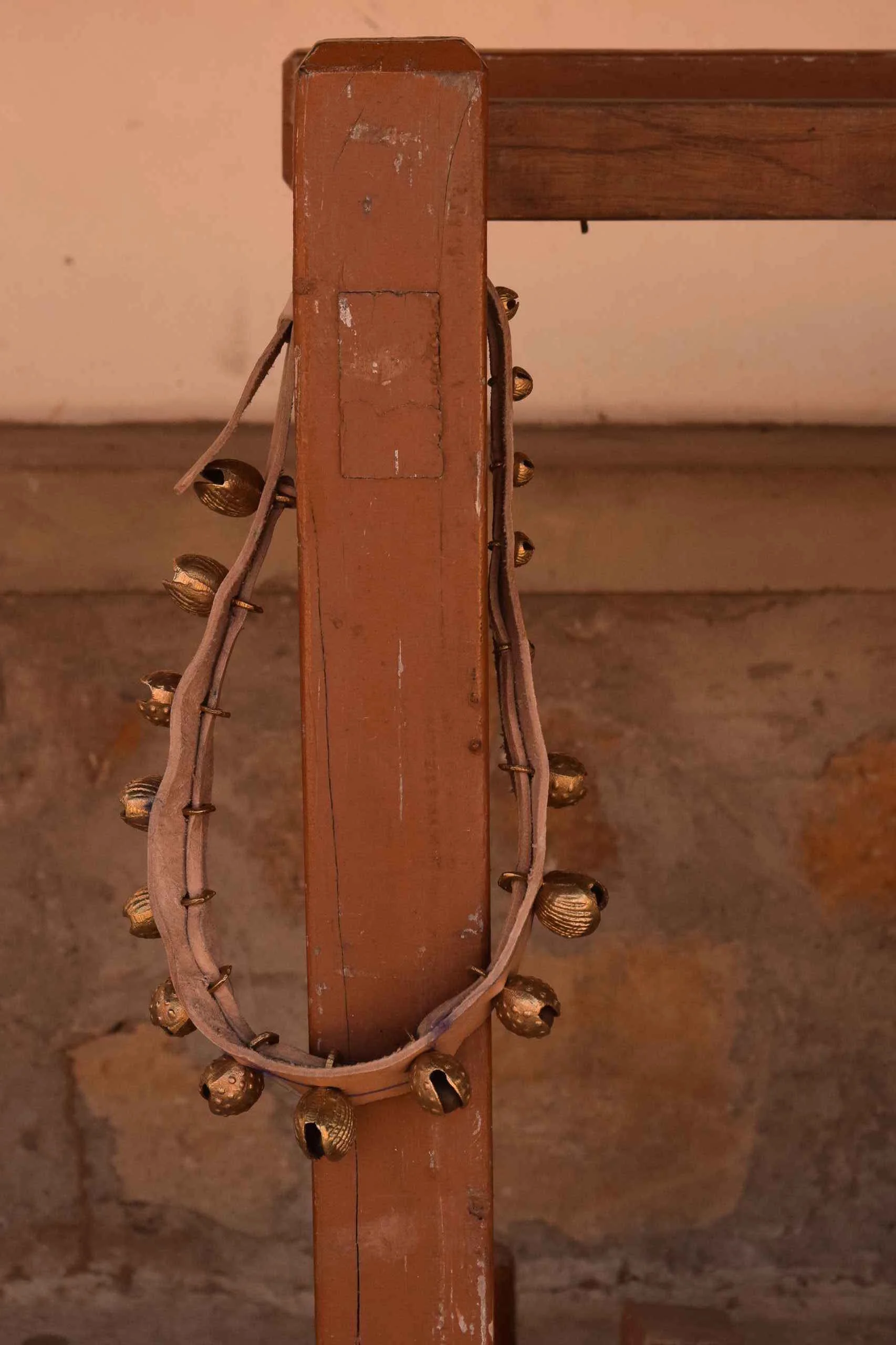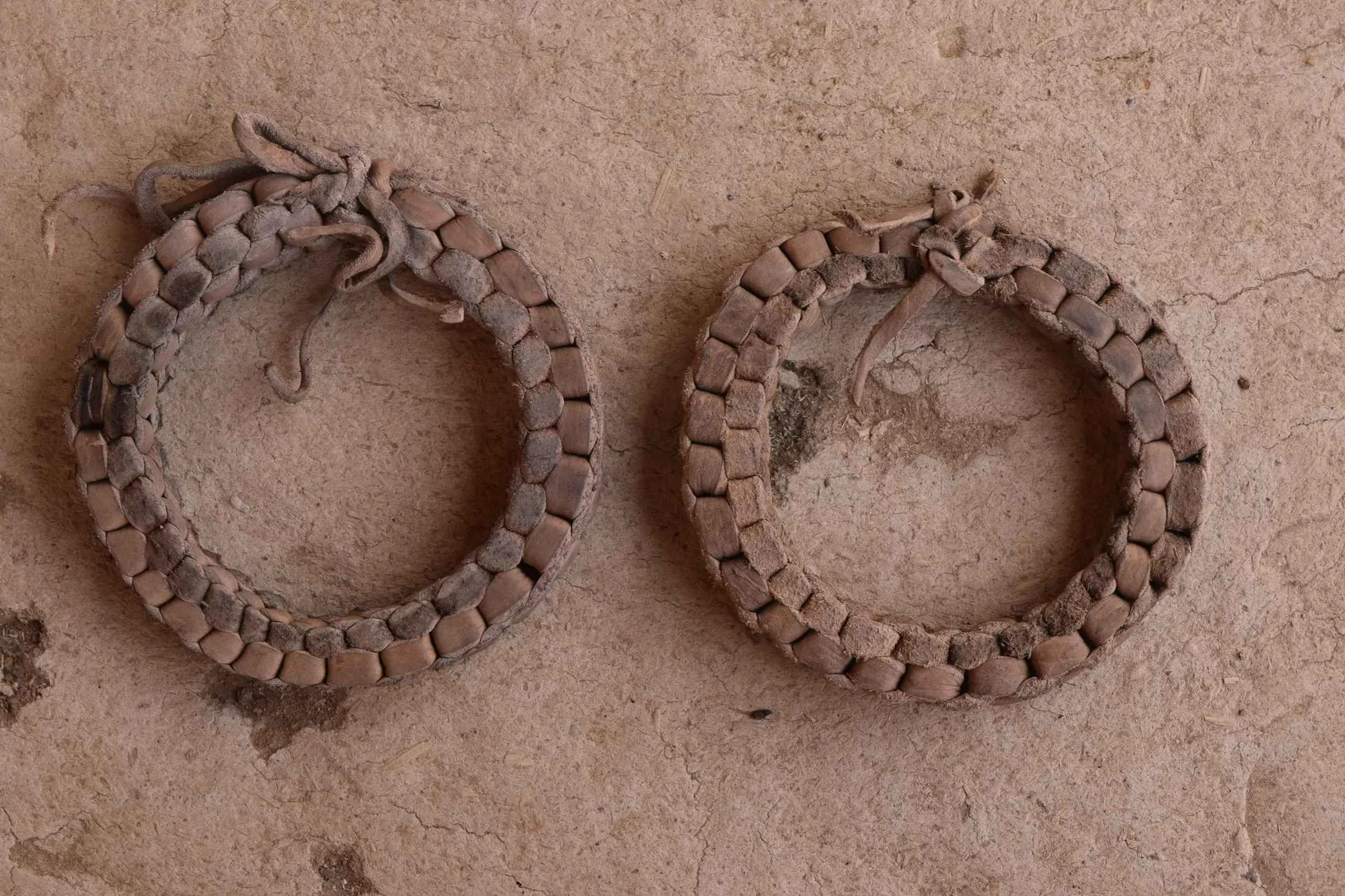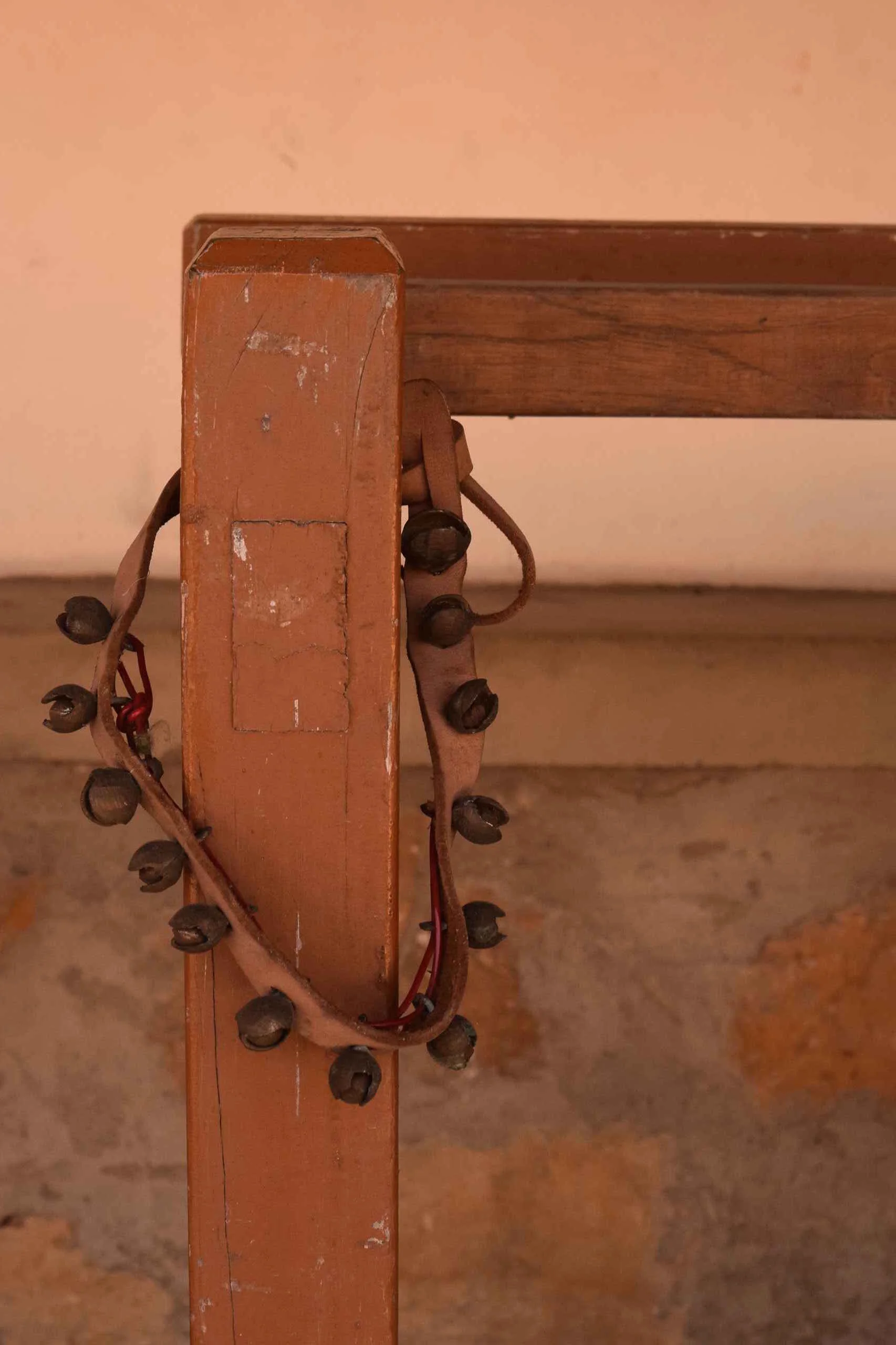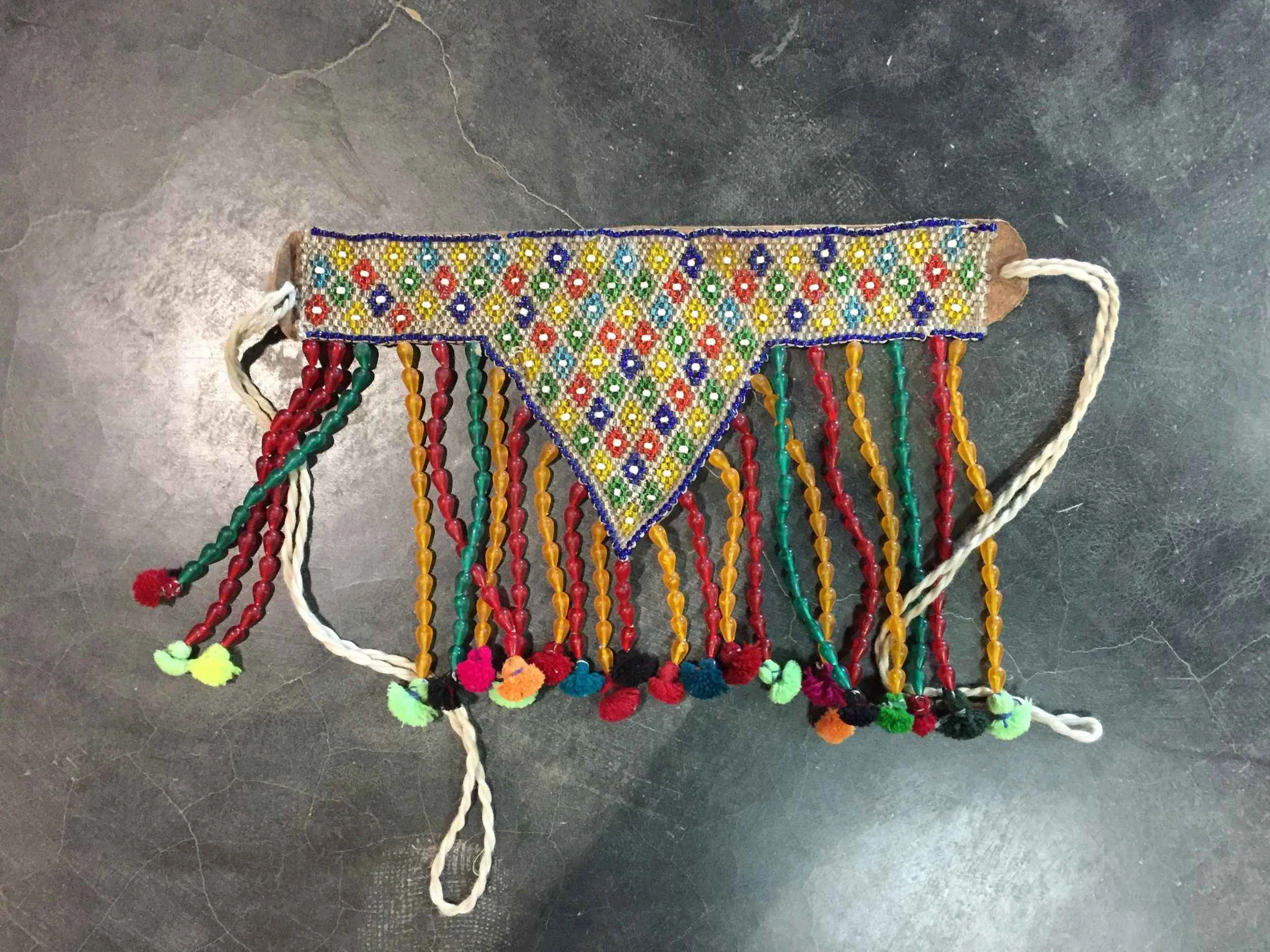Shoes
Jhalani Jhootis are bedecked with intricate silver or zari work. Earlier Meghwars used real silver zari to adorn these shoes but these are now replaced with synthetic ones. The colorful torni border on the shoe was a favourite among the women. Both sides of the sole were etched by hand with floral designs and geometric shapes. These motifs varied according to the preferences of the community or the artisan. These shoes were popular amongst all the Kachchhi communities except the Rabaris, who preferred a more rugged style of work. In Banni, The leather artisan made a special pair of jhootis for the Maldhari bride. He would be welcomed with the shoes at the wedding to the beats of a drum and music. The shoes were blessed with offerings by guests and given to the artisan as a token of gratitude. Apart from this, he would be rewarded with either a baby cow, buffalo or goat, sometimes a camel. This system still exists in some parts of the Banni.
These shoes were made in vibrant shades of red, yellow and blue sourced from Khatri dyers, and ornamented with silver or zari work. Designs and cuts on the soles were differentiated by community. The Maldharis of the Banni region were the largest users of these.Along with the rest of the wedding attire, they would always keep these shoes safe as part of the wedding trousseau. The bridegroom’s family would bless the shoes during a wedding meal ritual. This is still prevalent in some parts of the Banni.
Getli Jhoota were widely worn across Kachchh, but were most popular among men in the Banni region. These shoes were a dark brown or red, with minimal zari work. They were made from cow or buffalo hide which yielded thick leather well suited to endure the harsh terrain of Kachchh. Built to last, these shoes had thick soles that lasted three to four years of continuous use. Maldharis would often requested specific identifying features in their shoes. The soles had geometric cut outs which left distinct, identifying footprints behind. Other features might include a metal horse shoe attached to the heel, or pieces of leather sandwiched between the layers of sole to would make a distinct sound while walking.
Getli Jhoota were widely worn across Kachchh, but were most popular among men in the Banni region. These shoes were a dark brown or red, with minimal zari work. They were made from cow or buffalo hide which yielded thick leather well suited to endure the harsh terrain of Kachchh. Built to last, these shoes had thick soles that lasted three to four years of continuous use. Maldharis would often requested specific identifying features in their shoes. The soles had geometric cut outs which left distinct, identifying footprints behind. Other features might include a metal horse shoe attached to the heel, or pieces of leather sandwiched between the layers of sole to would make a distinct sound while walking.
These shoes were simple and lightweight, with minimal design, and were used by the elder Maldhari men in Banni. Cutout motifs on the sole were present only if the user requested them.
These shoes were so named because of the distinctive tail at the back of the shoe. Because of the fine zari work, they were worn on special occasions by men in Banni. The pattern for the toe-cap could be pointed or rounded, depending on the wearer’s preference. The Mutwa Maldharis were particularly fond of this style.
These shoes were so named because of the distinctive tail at the back of the shoe. Because of the fine zari work, they were worn on special occasions by men in Banni. The pattern for the toe-cap could be pointed or rounded, depending on the wearer’s preference. The Mutwa Maldharis were particularly fond of this style.
These were daily wear shoes with thin and lightweight soles. The distinct feature of these shoes was a gap of exact two figures between the phadiyan half sole and heel.The width of the sole was kept extremely narrow to maintain lightness.
The word ‘Sapaat’ means flat. The shoes were simple and had a rough finish. They were popular among middle-aged and older women in East Kachchh. Rounded toe caps were worn mostly by the Wagadiya Rabaris (sheep and goat herders), Durbars or “upper caste” Hindus and Gadhvi (cattle herders and farmers). Slightly pointed toe-caps were popular among the Ahir (farming) women.
The word ‘Sapaat’ means flat. The shoes were simple and had a rough finish. They were popular among middle-aged and older women in East Kachchh. Rounded toe caps were worn mostly by the Wagadiya Rabaris (sheep and goat herders), Durbars or “upper caste” Hindus and Gadhvi (cattle herders and farmers). Slightly pointed toe-caps were popular among the Ahir (farming) women.
The word ‘Sapaat’ means flat. The shoes were simple and had a rough finish. They were popular among middle-aged and older women in East Kachchh. Rounded toe caps were worn mostly by the Wagadiya Rabaris (sheep and goat herders), Durbars or “upper caste” Hindus and Gadhvi (cattle herders and farmers). Slightly pointed toe-caps were popular among the Ahir (farming) women.
These flat shoes were worn by women across the Banni region. The pattern varied from other shoes in rest of the Kachchh with surface zari work.
These shoes with their distinct toe-cap and back tail were worn by Wagadiya Rabaris, the sheep and goat herders in the region of Wagad. The Rabaris had a taste for the rustic and the shoes therefore were heavy with a thick outsole with nails and rivets for decoration. They valued these shoes to such an extent that they often hung them safe on their walking sticks while on the move instead of walking in them.
Agrarian
The product was used by the farming communities of Kachchh. Post harvesting, farmers would tie the crop yield onto the cart with the naadi and carry it to the storage areas. The skill needed to twist and braid leather has become relatively uncommon in present day Kachchh. Since the naadi was used rigorously, it needed to have enough strength and ability to last. To make it, two people would hold the pieces of leather at both ends while twisting and adding to its length.
Various straps and fittings for carts used by Ahir farmers were made from leather. Jotar was a broad leather piece that was passed under the bull’s neck with loops on either end to attach it to a cart.
This was used during the harvest season. The farmers used it to fling stones, producing a distinct loud sound that scared away birds. Gophans especially were exchanged for grains.
This was hung beneath a farmer’s bullock cart to carry water pots, and was also hung on ceilings at home to keep food away from pests. Though it was often made from animal hair and other fibres, chheekos made from leather were especially prized. Numerous patterns and braiding styles for its strength and structurewere used. These have been replaced by other substitute materials in the present day.
Supdo was made of dry grass stalks whichwere wrapped and stitched with goat leather. This technique resulted in an even surface that prevented the chaff or grains from getting trapped in gaps. It had raw and bold stitches all over to ensure tightness of the leather with the grass underneath.
Lifestyle
These were made from soft goat leather to allow folding and were structured into a flexible bucket. Chadai of various sizes were used in areas with scarce and shallow water. The wooden component that held the leather piece and kept its mouth wide open was made by the carved wood artisans. The stitched leather was turned inside out to ensure that water remained in contact with the smoother side of the leather.
Made out of thin leather, noro was a hidden waist belt used to carry coins under the shirt. When the Maldharis of Banni moved with their animals and travel for selling ghee or clarified butter, they would often wear noro as a pouch for keeping coins.
This vessel was made from goat leather. The skin was removed with a precaution such that it wouldn’t tear at critical joints and came out in one piece from the neck, back and limbs. The portion of neck was kept open as a mouth for the vessel and was closed with a leather string. The sandhaari was used by the Maldharis and other communities while traveling and feeding cattle. Due to its cooling properties, leather was considered an ideal material for water storage. The leather was turned inside out so that the cleaner and porous side of the skin was inwards which allowed water to seep out and evaporate, keeping the leather body and the water inside cool.A saandhaari could carry5-10 liters of water.
Bigger than the sandhaari, the sandhaaro was also made from goat leather and was used for storing water in gatherings where larger quantities were needed. It could contain up to 15-20 liters.
Meghwar women wear a set of ivory bangles on their upper arm as a mark of marriage. The kasiyawas tied at the elbow to prevent these bangles from slipping when they move.
This circular piece of leather was kept under the head of a newborn baby to keep it cool and steady. On the sixth day after birth, when the baby is ritually welcomed in the family, a leather artisan would bring the taalki to the family and be suitably rewarded. The taalki is variously known as chhithri, khaladi, khadki and sagi by various communities in Banni. It is still commonly used across Kutch and sourced locally from the leather artisans. The family would apply oil on to it to keep the leather cool for the baby’s head.
This leather string with two wooden pieces on each end helped rotate the mandhdi, the stick for churning chhaas or buttermilk. Chhaas was, and still is, an important part of the daily diet due to the predominant milk economy of the region. It is also said to keep the body cool in the extreme heat.
This leather belt was wrapped around the neck of the pot and fastened against a pole or wall to keep it intact while churning chhaas.
A leather cover to hold the sword was an important part of the bridegroom’s dress and was fitted into a patto, a leather waist belt. Adorned with intricate zari work, the product was perfect for a wedding. It is still worn in Hindu weddings across Gujarat.
This set of two ropes with loops on both the ends was tied on the cradle, with one end held for rocking. It was made by twisting leather strings together to add to its strength. It was common across all Kachchi communities.
This is an example of the amalgamation of two crafts - a terracotta pot with a piece of leather on its mouth. It is still a very popular form of percussion in Kachchhi folk music in the Banni region. The musician would select the desired pot from the potter and take it to a leather artisan for the leather piece, which has to be very thin and preferably of a young goat. He would sit with the artisan, adjust and tune it and then tie the leather piece accordingly. It produces a distinct echoed sound and has to be wetted from time to time.
Animal Decoration
Cattle herders decorated, and still decorate, their cattle with bells and beads. This was a reflection of their relationship with their animals. This leather collar with single metal bell was tied along the neck of a cow, bull or camel. A ghoogarmal had more bells.
Camels were decorated in these eight-bell straps on the occasion of a wedding in a camel herder’s family in Banni. These alsoserved a sensory purpose as their sound helped to trace the whereabouts of the camel.
This is like a face mask with elaborate bead work on a leather base. It was used by the camel herders in Banni to adorn their camels on special occasions. The patch of bead work is made by the woman in the family which is later laid out on leather and stitched by the leather artisan. Meghwar women are known for their intricate bead embroideries.
This features elaborate beadwork to cover the face of the horse. It is placed on the forehead and is used to adorn the horse on special occasions. Meghwar women are known for doing beautiful intricate bead work, so the product is a result of the combined work of both the women and men.
Since camels were an important means of transportation in Kutch and among all cattle herders, there were numerous camel herding communities, so the need for saddlery and other accessories was prominent. Majority of these pieces today have been replaced with other textile materials.
